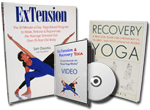View the Teacher Training Outline
Teacher Training Workshops Designed for All Styles and Disciplines of Yoga
Our teacher training workshops are designed for yoga teachers of all styles and disciplines who are now experiencing the aches, pains, and injuries that have resulted from a vigorous or otherwise inappropriate yoga practice when they were younger.
Our workshops are also designed for yoga teachers who want to avoid pain, strain, or potential injuries in the future. And they are for yoga teachers who now work with, or who want to work with injured, ill, and/or aging students.
Our introductory workshops are divided into three components:
- The Introduction - How and Why Yoga Works
- How Theory Applies to Teaching
- How Theory Directly Applies to the Yoga Teacher's Personal Practice
The Introduction – How and Why Yoga Works
Because this material is both counter-intuitive and misunderstood, attendance to the Introduction is required for all yoga teachers who wish to participate in the workshop.
The Introduction focuses upon the logic, principles, and science that supports “an appropriate yoga practice” and “how to get more by correctly doing less," The Introduction is an experiential lecture wherein the participants will actively experience the logic, principles and science being taught.
During the Introduction, participants will learn that new and experienced yoga students alike (even yoga teachers) MUST approach yoga differently:
- When people who practice yoga are younger than 28 to 32 years of age regardless of past injury
- When people who practice yoga are older than 28 to 32 years of age and have never experienced substantial injury or chronic illness
- When people who practice yoga are older than 28 to 32 years of age and are currently experiencing or have experienced substantial injury or chronic illness
- And when all ongoing yoga students and teachers who are growing older can no longer do the yoga they once did without exacerbating their pain and discomfort
How This Material Applies to Your Teaching
Participating yoga teachers are asked to invite one or two of their “problem” students to join our classes so everyone can see how the logic, principles, and concepts are applied to individual cases.
Participating yoga teachers are also invited to ask us for our feedback and advice about their own personal yoga related problems.
Over time, participants will see how general trends and patterns emerge that supports the logic, principles and science presented in this workshop ... along with the assertion that “less done correctly always gets us more.”
How Theory Directly Applies to the Yoga Teacher's Personal Practice
The remaining one or two classes are fully experiential and are designed to show you, as participating yoga teachers, how the very same logic, principles, and concepts taught throughout this workshop applies directly to your own personal yoga practice regardless of the style of yoga you are practicing and teaching.
In so doing, you as yoga teachers, will move your personal yoga practice toward the cardiovascular arena for enhanced flexibility, strength, and endurance without pain or strain.
Yoga teachers should come away from this seminar with a deeper understanding of how to “maximize their yoga potential and minimize their risk of yoga related injuries” both for their students and their own personal yoga practice.
There are many different yoga styles and approaches that focus on varying aspects of philosophy and exercise (asana). Most yoga styles in western culture emphasize the exercises and their teacher trainings are based upon their own specific techniques of practice and belief. we think it would be fair to say that in any system, there are good and bad teachers.
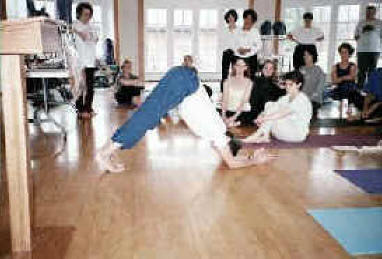
Any instructor who knows how to make use of generally accepted teaching methodology, who has a thorough understanding of their own particular style of yoga along with a basic understanding of anatomy and physiology, can certainly be an effective teacher.
However, a teacher of any system who also understands the mechanics of 'how and why' yoga affects the human body, mind, and spirit -- has the potential to become an exceptional teacher. Why? Because such a person can teach anyone; not just those who are like themselves, or those who are flexible, or strong, or young, or healthy.
Perhaps one of the most significant problems in yoga today is that young and healthy teachers, or teachers who are older but who have maintained their vitality through yoga -- do not have, nor can not have, a full conceptual understanding of how it feels to be “living” in a stiff, out-of-shape body. Or worse yet, what it feels like to have a body that is chronically ill, or chronically injured. Or what it feels like to have a normally aging body that has never experienced the joy of yoga.
It is critically important to recognize that even though a normally healthy instructor can be sensitive, and even empathetic, to chronically ill, injured, or aging students, unless that teacher has direct experience with long-term chronic physical distress, all such a teacher can do ... is guess what it feels like.
Teacher Training - A Personal Evolution Since 1978
Sam did our first Teacher Training in 1978. Since then, both our Trainings and personal practice have undergone considerable change. As a vigorous young teacher, nearly everything about our personal practice, including our Teacher Trainings, were about performance. 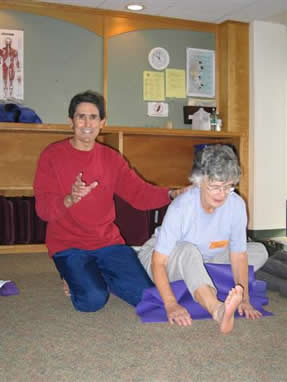
Sam had two main objectives during those early Trainings: The first was to show the participants how to “push their personal practice to the maximum.” The second objective was to show participants how to teach that maximum effort to their students.
We've learned a lot during the past 25 years and although our Teacher Trainings still have two primary objectives, those objectives have changed considerably.
Our first objective is to teach you, regardless if you are young or aging, healthy or not, how the various Neuromuscular Principles and Laws apply to your own personal practice. In so doing, you will learn how you can maximize your potential while at the same time, minimize your risk of injury from unnecessary forcing or straining—-in other words, how to safely influence the strength, endurance and flexibility of your practice—-physically, emotionally and spiritually.
Along with varying amounts of yoga philosophy, anatomy, and physiology, almost every other style of yoga teacher training today teaches technique; that is, how to teach a particular asana or pose. We certainly emphasized technique in our early Trainings, but our current Trainings have conceptually changed.
Our second objective therefore, is to promote an understanding of how and why yoga works. Those who understand the mechanisms of how and why yoga works on the human body and mind, can enhance their intuitiveness as a teacher. With literally thousands of asana to choose from, and with the infinite variability of students and ability, it's impossible to learn technique for each and every one.
But by utilizing both the intellectual and instinctive foundations developed from Teacher Training, you can effectively teach anyone; from athletes to sedentary couch potatoes; from normally healthy people to the chronically ill and injured; from youngsters to aging people…and everyone in between.
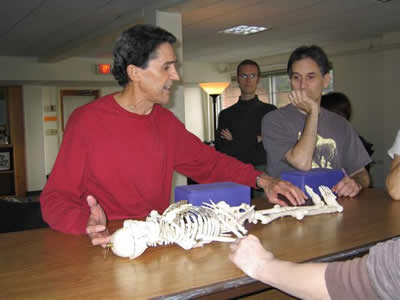
The Process of Teacher Training
Your Training begins with your own experience. we will invite you to practice some basic yoga exercises and will then ask you the two most fundamentally important questions of the Training: What is yoga? and, How does it feel? Your responses will prompt the introduction of specific and relevant Neuromuscular Principles and Laws that address these two questions.
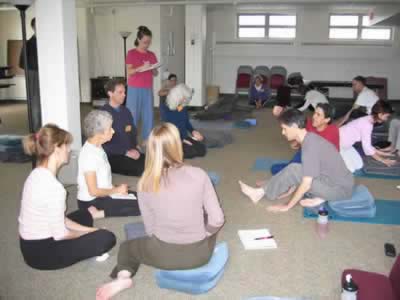
As you apply the Neuromuscular Principles and Laws to your own yoga practice, we'll introduce specific anatomy and physiology that further clarifies the two essential questions. It doesn't take long to develop a deeper intellectual and intuitive understanding of how and why yoga works.
The elegance of your Training comes not so much from what we say or do, but from your own experience. In other words, as you apply the Neuromuscular Principles and Laws, you will be able to evaluate how you originally felt from your “old” exercise as compared to how you feel with your "newly adapted" yoga exercises.
Regarding the issue of Certification, the following email exchange was generated by a yoga teacher interested in bringing Sam to her locality for a weekend Teacher Training seminar:
Question:
Perhaps I misunderstood-I thought this weekend seminar would be to achieve the goal of Certification. Would there be some alternative ways of handling the Teacher Certification, for instance, how about if we booked you for a full week in June. Not everyone would be able to attend a full week, only a weekend. Could we offer those partially attending, a Certificate of Attendance, and then those students who do the whole week, a complete Teacher Training Certificate? Out of curiosity, what stands in the way of certification in our state?Sam Responds:
There are many yoga schools around the country that will give Teacher Training Certification with only a month of classes, and some give Certification after a single weekend training. On the other side of the spectrum, there are yoga schools affiliated with their state's educational system and offer Yoga Teacher Certification equivalent to a two-year college AA degree, such as those given in California.Most states have no requirements for Yoga Teacher Certification. Florida certainly doesn't. In other words, anyone can get a piece of paper saying they are certified and can begin teaching. Many teach yoga without certification; without ever attending a course, but have learned what they know from books, regular classes, and even from television.
To specifically answer your question, we have given Certificates of Attendance to yoga teachers who have studied with us, though we question their worth. We feel strongly enough about the work we do and will not certify in our style until they learn the material on our website and books, and can demonstrate that they can both practice and teach ExTension and Recovery Yoga..
Let's be totally honest: Other than the material on our website and in our books, you do not know us or who we are or what we really do. If you and your colleagues are truly serious about wanting to become certified to teach in our method, then we recommend you first bring Sam or us both to your area for a trial weekend, or maybe a four or five day seminar, wherein we will teach you the fundamental basics of what we do. NO ONE has learned our method in a weekend, but those attending will have enough information that they can begin in earnest to practice yoga in our style.
If after our first meeting, you and your colleagues still wish to study with us, then we will present a more formal and extensive course of study based on our website and books that will require a number of follow-up seminars. We will give Certificates of Attendance to each person who FULLY attends each separate group of classes and we will give Teacher Certification to only those who successfully complete the entire series of seminars. Those who's attendance is incomplete will not receive Certification without making up the lost work.
Finally, we wish to emphasize that those who take our course of study do not have to be flexible or strong of body, but of mind and spirit. Our style is initially difficult to both practice and teach, because it's so counter-intuitive.
To successfully practice our method requires attendees to work easier, not harder. Yet, those who learn the method will enhance their flexibility, strength, and endurance. Those who complete the course of study will learn the specific principles and laws that makes yoga so powerful, and will be able to apply those principles and laws to their own personal practice and teaching.
In conclusion: The first seminar introduces the attendees to the basics of ExTension and Recovery Yoga. Subsequent seminars refine what was introduced previously, and then use that material as a steppingstone for future exploration. The series of seminars examines:
- Basic Theory: How and Why Yoga Works
- How to safely practice the different modes of yoga exercises
• Warm ups Sun Salutations
• Standing Poses
• Forward Bends
• Back Bends
• Inversions
• Twists
• Savasana
• Breath control
- And how to teach what you practice to all levels of people, from the chronically ill, injured, and aging, to young vigorous athletes…And to everyone in between.
 Return to Top
Return to Top

